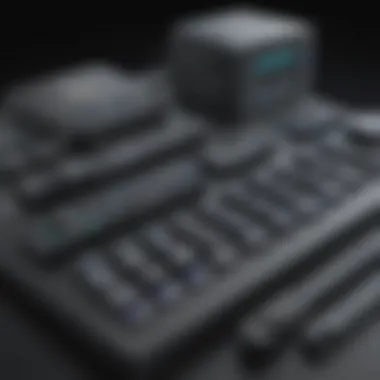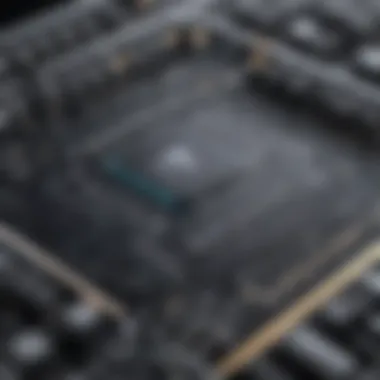System Requirements for ChiroTouch Performance


Intro
In today’s healthcare landscape, effective management of patient information and operational efficiency is crucial for chiropractic practices. ChiroTouch has emerged as a prominent software solution tailored for the chiropractic field, designed to facilitate seamless patient management and practice workflows. Understanding the system requirements for ChiroTouch is essential to harness its full potential.
This article discusses the critical components that ensure ChiroTouch performs optimally. This includes a breakdown of the necessary hardware, software, and network configurations. By recognizing these requirements, chiropractic practices can enhance user experience and ultimately improve patient care.
Following this introduction, the article will cover a comprehensive overview of the software, comparing it with its competitors in the market. We aim to provide insights that support informed decision-making regarding infrastructure investments for organizations looking to implement or upgrade their ChiroTouch systems.
Software Overview
Definition and Purpose of the Software
ChiroTouch is an all-in-one practice management software specifically designed for chiropractic clinics. Its primary purpose is to streamline operations, from scheduling appointments to billing and record keeping. By integrating these functions into a single platform, ChiroTouch helps practices reduce administrative burdens and focus more on patient care.
Key Features and Functionalities
ChiroTouch offers a range of features that cater to the diverse needs of chiropractic clinics:
- Appointment Scheduling: Easily manage patient appointments and reminders, reducing no-shows and improving overall clinic efficiency.
- Electronic Health Records (EHR): Maintain comprehensive patient records digitally, ensuring compliance with healthcare regulations.
- Billing and Insurance: Simplify the billing process with in-built insurance claim tracking and financial reporting capabilities.
- Patient Portal: Provide patients with access to their health information, improving engagement and communication.
- Reporting: Generate detailed reports to analyze practice performance and patient outcomes.
These features collectively contribute to an enhanced operational workflow, allowing practitioners to dedicate more time to healing and less to administrative tasks.
Comparison with Alternatives
Overview of Competitors in the Market
ChiroTouch, while a powerful tool, does face competition from various other software solutions. Prominent alternatives include:
- Kareo: Focuses on the medical sector with customizable billing features.
- ClinicTracker: Known for its robust patient management capabilities and customizable interface.
- Practice Fusion: Offers a free EHR solution but may lack some advanced features specific to chiropractic practices.
Key Differentiators
What sets ChiroTouch apart from its competitors? Several factors play into its competitive advantage:
- Chiropractic Specialization: Unlike more generalized platforms, ChiroTouch is designed specifically for chiropractors, incorporating industry-specific requirements and workflows.
- User-Friendly Interface: Many users report that ChiroTouch’s interface is intuitive, requiring less training time for staff.
- Comprehensive Functionality: The all-in-one nature of ChiroTouch—combining EHR, practice management, and billing—reduces the need for multiple systems, simplifying operations.
These differentiators contribute to the continued popularity of ChiroTouch among chiropractic practitioners, providing specific tools and features that others may overlook.
"An optimized system not only enhances efficiency but also improves patient satisfaction and care outcomes."
As practices consider adopting or upgrading their systems, understanding these functional aspects will aid in making educated decisions about their technology investments.
Understanding ChiroTouch and Its Purpose
ChiroTouch is an integrated software solution designed specifically for chiropractic practices. Its purpose extends beyond mere record-keeping; it aims to enhance operational efficiency and improve patient care. Understanding the ChiroTouch system is essential for any practice looking to streamline its processes and provide better service to patients.
The software offers numerous features, including scheduling, billing, and documentation, tailored to meet the unique needs of chiropractors. By centralizing these functions, ChiroTouch reduces administrative burdens and enables practitioners to focus on patient outcomes rather than paperwork.
Overview of ChiroTouch Software
The ChiroTouch software is a comprehensive platform meant for chiropractors. It simplifies patient management through automation and user-friendly interface. Staff can easily access patient records, appointment schedules, and billing information in one place. This configuration not only cuts down on time spent searching for information, but it also minimizes the chances of errors.
Additional functionalities such as electronic health records (EHR) and practice management tools allow practitioners to maintain accurate documentation of treatments. The user can tailor the software to fit their individual workflows, making it a versatile tool for various practice sizes and specialties.
Importance of System Requirements
Understanding system requirements is fundamental for ensuring ChiroTouch operates smoothly. Ensuring that hardware and software specifications are met can prevent performance issues that might lead to frustration and inefficiencies.
System requirements determine how well the software runs in a given environment. Without the necessary hardware or operating system, users may face slow response times, crashes, or even data loss. Proper configuration helps in maximizing the benefits of ChiroTouch, enhancing the overall usability and functionality.
It is crucial for businesses to evaluate their current infrastructure against ChiroTouch's requirements. This evaluation helps in making informed decisions about upgrades or changes needed for optimal performance.
"Investing in the right system requirements is not just a technical decision; it is about empowering your practice to deliver better patient care."


By recognizing the importance of system requirements, chiropractic practices can position themselves for success, ensuring that they leverage ChiroTouch's full potential.
Hardware Requirements for ChiroTouch
Understanding the hardware requirements for ChiroTouch is vital for ensuring optimal performance of the software. The efficiency of ChiroTouch heavily relies on the underlying hardware that runs the application. Poor hardware can lead to slow load times, lag during use, and an overall inefficient workflow within a chiropractic practice. Therefore, knowing these requirements allows businesses to invest wisely in their technological infrastructure for better user experience and patient management.
Minimum Hardware Specifications
The minimum hardware specifications are the baseline required to operate ChiroTouch effectively. Installing the software on systems that fail to meet these minimum requirements often results in subpar performance.
Some key minimum specifications include:
- Processor: A dual-core processor with a frequency of at least 2.0 GHz.
- Memory: 4 GB of RAM, which suffices for basic operation but may not handle multiple tasks efficiently.
- Storage: A minimum of 500 GB hard disk space.
- Graphics: Integrated graphics that can support a screen resolution of 1024 x 768.
These specifications primarily ensure that ChiroTouch can function without frequent crashes or sluggishness, especially in small practices with limited patient loads.
Recommended Hardware Specifications
To utilize ChiroTouch fully and ensure a smooth and responsive experience, the recommended hardware specifications must be considered. While the minimum specifications may suffice for basic operations, enhancing the hardware can lead to significant performance improvements.
Recommended specifications include:
- Processor: A quad-core processor, ideally with a frequency of 3.0 GHz or higher, for brisk performance.
- Memory: A minimum of 8 GB of RAM to accommodate multiple open sessions and applications without slowdown.
- Storage: Solid State Drive (SSD) with at least 1 TB of capacity is advisable for faster data access and retrieval.
- Graphics: Dedicated graphics card that supports higher resolutions and multiple monitors, enhancing the overall user experience when navigating through the ChiroTouch software.
These recommendations can significantly improve the efficiency of ChiroTouch, helping users manage ongoing patient care seamlessly.
Impact of Hardware on Performance
The hardware used significantly impacts the performance of ChiroTouch. High-quality hardware components facilitate faster data processing, smoother navigation, and quicker access to patient records. Conversely, substandard hardware leads to interruptions, crashes, and potential data loss, which can be particularly detrimental in a health care setting.
Several aspects illustrate this impact:
- Speed: Faster processors reduce latency, ensuring that users can navigate the software more fluidly.
- Multitasking: Adequate RAM allows multiple applications to run simultaneously without hindering performance.
- Data Management: Sufficient storage affects how quickly data, reports, and files can be accessed.
In summary, hardware requirements for ChiroTouch play a crucial role in stabilizing the operations of a chiropractic establishment. Investing in proper hardware is not merely an enhancement; it is essential to maintaining an efficient and effective practice.
"Selecting the right hardware is not just about meeting minimum specs; it’s about investing in a system that fosters productivity and enhances patient care."
Understanding these hardware elements ensures that chiropractic practices can optimize their use of ChiroTouch, leading to improved workflows and patient satisfaction.
Software Requirements for ChiroTouch
Understanding the software requirements for ChiroTouch is crucial for ensuring a smooth and effective operation of the system. The performance of ChiroTouch depends not only on hardware but also on the right software components being properly installed and configured. These requirements dictate how well the software integrates with the existing infrastructure of a facility, ultimately affecting user experience and patient management capabilities. By focusing on the specific software requirements, businesses can secure a robust environment that supports operational needs without unexpected hiccups.
Supported Operating Systems
ChiroTouch software supports several operating systems, and selecting the appropriate one is vital. The primary systems include Windows 10 and later versions. It is important to ensure that these operating systems are up to date, as they provide the necessary security and functionality that ChiroTouch requires for optimal performance. Running outdated versions can lead to performance degradation and security vulnerabilities.
Utilizing the right operating system allows the software to leverage system resources effectively. This can enhance multitasking capabilities, allowing healthcare providers to manage patient records while processing billing or scheduling. Here's a summary of the supported operating systems:
- Windows 10: Best performance and support.
- Windows 11: Compatibility dependent on updates.
Choosing the correct operating system is foundational but often overlooked. Many practices run into issues because they do not consider the architectural differences between operating systems. Furthermore, organizations should plan for regular updates to their operating systems to avoid compatibility issues down the line.
Necessary Software Components
Beyond the operating system, several software components are necessary for ChiroTouch to function correctly. These components are typically pre-installed, but ensuring they are present and up to date is crucial.
- Database Software: ChiroTouch often utilizes a specific database management system to handle patient records efficiently. It is important to verify the compatibility of this database with the system’s hardware and network.
- Antivirus and Security Software: Security is paramount in healthcare. The right antivirus software should be compatible with ChiroTouch and regularly updated to protect sensitive patient information.
- Backup Software: Regularly backing up data is a sound practice. Ensuring the presence of reliable backup solutions can safeguard against data loss.
- Remote Desktop Software: In some cases, practices may require remote access to ChiroTouch. Remote desktop applications facilitate this access but must be compatible with the existing setup.
By ensuring that all necessary software components are correctly installed and updated, practices can avoid common pitfalls that may compromise system performance. Collectively, these factors contribute significantly to the overall functionality and effectiveness of the ChiroTouch system in a clinical environment.
Network Requirements for ChiroTouch
Understanding the network requirements is essential for utilizing ChiroTouch effectively. A robust and reliable network connection directly influences the performance of this chiropractic software. Performance issues may arise if network requirements are not met, affecting both user experience and patient management capabilities.


Bandwidth Considerations
Bandwidth is a critical aspect when considering the network setup for ChiroTouch. Adequate bandwidth ensures that data transfers occur smoothly, especially when multiple users are accessing the system simultaneously. To define the suitable bandwidth:
- Consider the number of users that will operate the system at the same time.
- Account for data-heavy operations, such as processing patient records or integrating with other systems.
- Aim for a minimum of 10 Mbps for small practices, but larger setups may need more capacity.
It is important to regularly monitor bandwidth usage during peak hours. This helps in identifying potential bottlenecks early.
Network Connectivity Options
The choice of network connectivity plays a significant role. There are several options available, each having its advantages and disadvantages.
- Wired Connections: These provide superior stability and speed. They are less susceptible to interference, making them ideal for environments requiring reliable communication.
- Wireless Connections: While convenient, wireless networks can experience interruptions. Implementing Wi-Fi 6 technology can mitigate some issues but maintain a fallback to wired connections if needed.
- VPNs: For remote access, a VPN ensures data security. However, it may add some latency that could impact performance. It is crucial to choose a VPN service that complements network speed requirements.
Your choice should align with the specific needs of your practice, factoring in location, technology readiness, and budget constraints.
Security Protocols and Practices
The security of patient data is paramount in any healthcare software, including ChiroTouch. A compromised network not only jeopardizes sensitive information but can also result in legal consequences.
It is vital to implement robust security measures:
- Use firewalls to shield internal networks from external threats.
- Enable encryption for data being transmitted over the network to protect against interception.
- Establish strong passwords and enforce regular updates to protect user accounts.
Further, conduct regular training sessions for staff to increase awareness about phishing attacks and other cybersecurity threats. Keeping software updated also aids in mitigating vulnerabilities.
Properly addressing network requirements ensures that ChiroTouch operates efficiently and securely. This ultimately supports better patient care and practice management.
By focusing on these elements, small to medium-sized businesses can ensure the optimal performance of ChiroTouch, enhancing their overall operational efficiency.
Installation and Configuration of ChiroTouch
Installation and configuration of ChiroTouch are crucial steps to assure its effective functioning. Proper setup guarantees that the software runs smoothly and efficiently. Misconfiguration can lead to performance issues, which directly affect user experiences in clinics. Without proper installation, the sophisticated features of ChiroTouch may become inaccessible, thus undermining the software's intended benefits.
Preparing for Installation
Preparation for installation involves several steps. Firstly, ensure that your hardware meets the recommended specifications. Verify that your operating system is compatible with the ChiroTouch software. This compatibility is vital since using an unsupported OS can lead to errors and malfunctions.
Next, consider creating a backup of existing data. This helps to prevent any data loss during the installation process. Additionally, ensure that your network is stable and secure to enable a smooth installation experience. Gather all necessary installation files and documents provided by ChiroTouch as well.
- Check hardware specifications
- Verify OS compatibility
- Backup existing data
- Ensure network stability
- Gather installation files
Step-by-Step Installation Process
The actual installation process is straightforward. Start by executing the setup file downloaded from the ChiroTouch portal. Follow on-screen prompts that guide you through the installation steps. Ensure that you grant necessary permissions to the software for optimal performance.
- Locate and run the installation file.
- Agree to the licensing terms.
- Choose the installation location.
- Complete the installation wizard.
- Restart the system if prompted.
Once installed, the software may require some initial configuration. Be prepared to set up user accounts and define preferences based on practice needs. This is important for tailoring the software functionalities to better suit your workflow.
Configuration Best Practices
Post-installation configuration is equally important. Start by adjusting settings that define user access and roles. Effective access control enhances security and ensures that sensitive patient information is protected. It is advisable to create user groups based on functionality requirements, limiting access where necessary.
Moreover, regularly review and update these configurations to match evolving practice needs. Monitoring system performance will provide insights into any necessary adjustments.
Remember, proper configuration can significantly enhance ChiroTouch's efficiency and user satisfaction.
To maintain optimal configuration, consider the following:
- Regularly review user access and roles.
- Keep the software updated with the latest patches.
- Document all changes made during configuration.
- Train staff on using the software effectively.
By paying close attention to the installation and configuration processes, practices can utilize ChiroTouch to its full potential, ultimately improving overall patient management.


Common Issues Related to System Requirements
Understanding the common issues related to system requirements for ChiroTouch is vital for ensuring smooth operations within a chiropractic practice. An awareness of these issues not only helps in maintaining efficient workflows but also plays an essential role in enhancing user satisfaction and patient care. It’s not just about having the right hardware and software; the synergy between these elements defines the overall performance of the system.
Identifying Performance Bottlenecks
Performance bottlenecks can significantly hinder the functioning of ChiroTouch. Identifying these bottlenecks involves closely monitoring the system's performance metrics. The most common signs include slow response times and difficulty in running multiple tasks simultaneously.
- Hardware Limitations: Insufficient RAM or a slower processor can lead to lagging, especially when accessing patient records or generating reports. Performing a hardware health check can pinpoint these limitations.
- Network Delays: High latency or insufficient bandwidth can slow down data transfer, leading to frustrating delays. Regularly testing the internet speed is advisable to ensure the network can handle the demands of the software.
- Software Configuration: Sometimes, issues arise from incorrect configurations. Ensuring that ChiroTouch is optimized for the specific setup in use can mitigate performance issues. Reviewing settings regularly is a proactive measure.
- Database Optimization: Over time, databases can become bloated with obsolete data. Regular database maintenance is crucial for smooth operations.
"Identifying performance bottlenecks is not an event; it's an ongoing process that can greatly enhance your system's efficiency."
Troubleshooting Common Problems
Troubleshooting forms the core of maintaining optimal performance in a ChiroTouch environment. Being equipped to address common problems can save time and resources. Here are a few common issues and their respective solutions:
- Application Crashes: If ChiroTouch frequently crashes, ensure the software is updated. Often, updates include important patches that fix bugs causing crashes.
- User Access Issues: If users face login problems, check their credentials and ensure they have the necessary permissions. Sometimes, servers may require a restart to refresh access settings.
- Integration Problems with Other Software: When ChiroTouch integrates with third-party applications, issues can arise. Ensure compatibility and consult documentation when issues occur. Also, reviewing the setup can prevent most integration hiccups.
- Data Syncing Issues: Inconsistent data across devices can stem from poor network connections during syncing. Verify connectivity and try forcing a sync from the user interface.
- Training Gaps: Often overlooked, insufficient user training is a common cause of errors. Ensuring that staff are well-trained can mitigate user errors, leading to a smoother operation of the software.
By understanding these common issues and identifying performance bottlenecks, businesses can greatly improve their system's functionality and extend the lifespan of their technology investments. Regular assessments and updates are recommended to maintain an efficient and effective system.
Maintaining Optimal System Performance
Maintaining optimal system performance for the ChiroTouch software is crucial for any chiropractic practice. Such software is integral to daily operations, from managing patient records to scheduling appointments. If the system operates below ideal performance levels, the entire practice may suffer. Therefore, a clear strategy for maintaining peak performance can significantly enhance user experience and patient satisfaction.
Regular Updates and Maintenance
Regular updates and maintenance are the backbone of a high-performing ChiroTouch system. Software updates often include improvements to security, bug fixes, and new features that can streamline routines. Waiting too long between updates can lead to vulnerabilities. For example, failing to update can expose the system to malware or exploits by cybercriminals.
Organizations should schedule regular maintenance checks. These may involve running diagnostics to detect any errors and ensuring hardware is functioning well. Each component, from the operating system to specific ChiroTouch software features, should be routinely evaluated and optimized. This diligent approach minimizes the chances of significant disruptions in service, maintaining smooth operational flow.
"Coherent and proactive updates are essential in preventing potential issues before they become problematic."
Typical maintenance tasks include:
- Reviewing system logs for unusual activity.
- Checking for software updates and installing them.
- Monitoring disk space and clearing unnecessary files.
- Performing backups to safeguard data.
By incorporating these practices, a practice can ensure its ChiroTouch system remains on the cutting edge.
Utilizing Support Resources
Utilizing support resources effectively is another critical aspect of maintaining optimal system performance. ChiroTouch offers various resources including a customer support team, online forums, and knowledge bases. Engaging with these resources allows users to stay informed about best practices, system updates, and troubleshooting tips.
For example, accessing online documentation provides step-by-step guides for common issues. Furthermore, participation in user forums can lead to advice from other practitioners who face similar challenges. This peer support is invaluable for solving unique issues that may not be covered in traditional documentation.
Regularly checking support channels can provide insights into:
- Upcoming updates and features that can enhance functionality.
- Common problems faced by users and their solutions.
- Tips for optimizing workflows within the software.
In summary, maintaining optimal performance of the ChiroTouch system requires a proactive approach. Regular updates, systematic maintenance, and active utilization of available support resources combine to create a robust operational framework. Such diligence will not only improve functionality but also foster a more efficient environment for healthcare practitioners and their patients.
End and Final Thoughts
In summarizing the essential system requirements for the ChiroTouch platform, it is critical to recognize the direct correlation between these requirements and the software's performance in chiropractic practices. This article has elaborated on various aspects, covering hardware, software, and network specifications. Addressing these factors is not just about meeting minimum standards; it is about creating an environment where ChiroTouch can function seamlessly. This environment can enhance the user experience and improve patient management capabilities significantly.
The benefits derived from optimizing system requirements extend beyond mere functionality. They include reduced downtime, increased productivity, and enhanced patient satisfaction. Users must consider their own practices' unique needs when assessing their technology infrastructure. A thorough understanding of the key requirements can empower organizations to make well-informed decisions regarding their investments in technology.
"An optimized system not only ensures smoother operations but is instrumental in attracting and retaining patients."
In this closing section, it is vital to highlight the importance of continual updates and maintenance to keep up with evolving technology trends and best practices. Regular assessments of system performance can help identify potential areas for improvement and adjustments needed to enhance overall efficiency.
Recap of Key Requirements
- Hardware Specifications: Choosing the right hardware, both minimum and recommended, is foundational. This includes adequate CPU power, RAM capacity, and sufficient storage for the ChiroTouch software to operate efficiently.
- Software Components: Ensuring compatibility with supported operating systems and necessary software components is essential. Users need to stay updated with the latest versions for optimal functionality.
- Network Considerations: Bandwidth adequacy and secure connectivity options support better user experience and data safety. A reliable network determines the speed and reliability of accessing the software.
- Regular Maintenance: Continuing to update and maintain the system ensures that performance bottlenecks are resolved swiftly and effectively.
Future Considerations for Users
As the field of chiropractic care and technology continues to evolve, users of ChiroTouch must stay ahead of the curve. Looking towards the future, there are several key considerations:
- Technology Trends: Staying informed about upcoming technology trends will help align practice needs with emerging solutions. Users should watch for innovations that can improve practice efficiency and patient engagement.
- Scalability: As practices grow, scalability becomes crucial. Users must consider systems that easily scale up to handle increased patient loads.
- Integration Capabilities: Future system requirements should include ensuring that ChiroTouch can integrate with other tools and platforms, allowing for a more streamlined workflow across various practice management solutions.
- Feedback Mechanisms: Engaging with support resources and user communities will yield valuable insights into common issues and user experiences, which can guide future adjustments to system requirements.
In essence, the successful use of ChiroTouch hinges on a thorough understanding of its system requirements. Practitioners can create a robust infrastructure that sustains optimal performance and enhances patient care.















